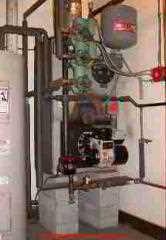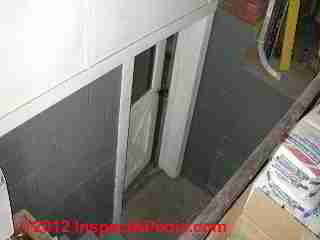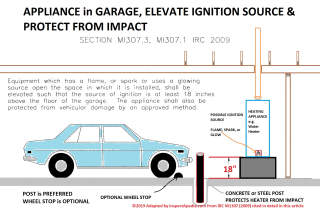 Gas or Oil Burners Must Be Above Garage Floor
Gas or Oil Burners Must Be Above Garage Floor
Code requires you to elevate an ignition source & protect from impact
- POST a QUESTION or COMMENT about this article topic
This article describes the requirement that sources of ignition in a garage, such as a heating boiler, furnace, or water heater shall be elevated at least 18" above the floor to reduce the chances of an explosion caused by igniting gas fumes that might originate from a vehicle in the garage or similar sources.
Photo: this oil burner is installed in a utility alcove that opens into a New York garage. There is no door on the utility space but its floor is 4" above the garage floor.
That was not sufficient elevation of the oil burner above the garage floor, so the installer used stacked concrete blocks to raise the oil burner itself more than 18" above the level of the garage floor.
InspectAPedia tolerates no conflicts of interest. We have no relationship with advertisers, products, or services discussed at this website.
- Daniel Friedman, Publisher/Editor/Author - See WHO ARE WE?
Building Codes Require Installer to Elevate Ignition Source & Protect from Impact
Oil and gas-fired heating equipment and other sources of ignition must be elevated above the garage floor sufficient to avoid a common source of ignition.
The concern is that leaks or fumes from a vehicle in the garage or possibly even fuel (unsafely-) stored in a garage can explode if ignited by any source of ignition in that space.
This elevation, usually achieved by putting the heater up on concrete blocks, is required by some building codes that specify that the water heater must be elevated above floor level, for example for water heaters or heating boilers or furnaces installed in a garage.
[Click to enlarge any image]
Note that many new water heaters are FVIR rated or "Flammable Vapor Ignition Resistant".
IRC Mechanical Code Section 69. APPLIANCES INSTALLED IN GARAGES.
Section M1307 IRC 2009 - furnace (or boiler or water heater etc) in a garage
M1307.3 Elevation of ignition source.
Appliances having an ignition source shall be elevated such that the source of ignition is not less than 18 inches (457 mm) above the floor in garages.
For the purpose of this section, rooms or spaces that are not part of the living space of a dwelling unit and that communicate with a private garage through openings shall be considered to be part of the garage.
M1307.3.1 Protection from impact.
Appliances shall not be installed in a location subject to vehicle damage except where protected by approved barriers.
Requirement to Elevate Oil & Gas Appliances No Less than 18" Above the Garage Floor
Original source of the text and illustration above:
- Stevens WA, COMMONLY USED RESIDENTIAL BUILDING CODES, IRC 2009, [PDF] retrieved 2019/05/08 original source: http://www.co.stevens.wa.us/landservices/documents/MECHANICALSECTION.pdf
- Other sections of this mechanical code are given
at CHIMNEY HEIGHT & CLEARANCE CODE - STATEN v. McNEAK, 41,117
930 So. 2d 360 (La. Ct. App. 2006)
Excerpt: ... the explosion was caused by a pilot light in the water heater, which was located in the laundry/utility room, adjacent to the kitchen.
Mr. Staten's expert, John Maroney, opined that the water heater was installed contrary to code and in violation of the heater's warning label.
More to the point, he stated that the heater had not been installed 18 or more inches from the ground, as recommended by code and the warning label.
To the contrary, Allstate's "fire and origin" expert, Gary Brooks, concluded that the water heater's warning label was ambiguous and that the pilot light from the kitchen stove, not the water heater, caused the explosion.
The basis for his "stove theory" was derived from a telephone conversation with Elisha McNeal ("Dee"), Ms. McNeal's adult daughter, who witnessed the explosion.
During this telephone conversation, Dee conveyed to Mr. Brooks that she saw a fire start from the stove area and spread out across the kitchen.
In-Garage Stairs to Basement = An Explosion Waiting to Happen

Above in a variation of basement walk-out stairs we illustrate an unsafe entry stair passing from a residential garage into the home's basement.
Watch out: As heating equipment is most often found in the home's basement, imagine the explosion that may occur (one did, despite our emphatic warnings, in Fishkill NY) if a vehicle leaks gasoline and gasoline fumes into the garage.
Gasoline fumes, heavier than air, fall down the stairwell, into the basement (or crawl space) where, at the next spark or flame, there is risk of an explosion
A "fire door" in the stairwell bottom is not enough security for this installation. In fact, as you can see, the (not fire-rated) door has been left ajar.
See also BASEMENT WALKOUTS & COVERS
See details about the requirement for self-closing doors and fire-rated doors
at GARAGE DOOR & DOOR OPENER SAFETY
...
Reader Comments, Questions & Answers About The Article Above
Below you will find questions and answers previously posted on this page at its page bottom reader comment box.
Reader Q&A - also see RECOMMENDED ARTICLES & FAQs
On 2017-07-19 by (mod) re: clothes dryer location vs gas furnace clearance distances
Heather:
The two worries, I suspect, nagging at your maintenance guys were
1. lint and dust from the clothes dryer may clog the combustion air inlet of your gas fired heating furnace, causing unsafe conditions and risking fatal carbon monoxide poisoning.
2. They might miss a chance to sell you a lint filter that you not only don't need, but that depending on the type and installation might itself be a serious fire hazard.
If your clothes dryer is properly and safely vented to the building exterior, the release of lint around the dryer itself ought to be minimal and not a safety hazard.
Start with a practical examination: is there dust visible in, on, or around your gas fired heating equipment? Is that dust dryer lint? If so, then a combination of housecleaning and an inspection of the dryer for dust and lint leaks is in order regardless of the dryer's exact placement.
Two feet more or less distance change from a clothes dryer that's leaking lint would not make one iota of difference in safety.
So where is the issue with clothes dryer distance to the gas furnace?
The answer is working space or fire clearances from combustibles that will be specified in the gas furnace installation manual for your specific heater. If the dryer is installed too close to the heater it violates the manufacturer's instructions, may prevent proper heater maintenance, and might be unsafe.
Using an American Standard Gas Furnace installation manual as an example, since you don't name your furnace brand and model, the word "clearance" appears 50 times in the document, showing that the manufacturer indeed has a worry about safe clearance distances for the heater.
Watch out: as you say two gas appliances are in your garage on the floor, there is also an explosion risk, as we explain above on this page.
Also see CLOTHES DRYER FIRE HAZARD WARNINGS
On 2017-07-19 by Heather: clothes dryer location vs gas furnace clearance distances
My maintenance guys said that my gas-heated clothes dryer and gas furnace are unsafe. They're both in the garage, and the clothes dryer just blows its exhaust onto the floor near my gas furnace.
Are they right? Why should I care? - Heather [paraprasing] 2017/07/19
...
Continue reading at PROTECTION BOLLARDS for MECHANICAL EQUIPMENT, or select a topic from the closely-related articles below, or see the complete ARTICLE INDEX.
Or see these
Recommended Articles
- BOILER CLEARANCE DISTANCES
- CLEARANCE DISTANCE, HVAC
- CLEARANCE DISTANCES for BUILDING SYSTEMS & FEATURES - topic home
- ELEVATE OIL or GAS BURNER 18" ABOVE GARAGE FLOOR
- FIRE CLEARANCES INDOORS
- FIRE CLEARANCES, SINGLE WALL METAL FLUES & VENTS
- FURNACE CLEARANCE DISTANCES
- GAS APPLIANCE / HEATER DIRECT VENT CLEARANCES
- OIL TANK CLEARANCE DISTANCES & LOCATIONS
- PROTECTION BOLLARDS for MECHANICAL EQUIPMENT
- WATER HEATER CLEARANCE DISTANCES
Suggested citation for this web page
ELEVATE OIL or GAS BURNER 18" ABOVE GARAGE FLOOR at InspectApedia.com - online encyclopedia of building & environmental inspection, testing, diagnosis, repair, & problem prevention advice.
Or see this
INDEX to RELATED ARTICLES: ARTICLE INDEX to HEATING FURNACES
Or use the SEARCH BOX found below to Ask a Question or Search InspectApedia
Or see this
INDEX to RELATED ARTICLES: ARTICLE INDEX to GAS APPLIANCES, PIPING, CONTROLS
Or use the SEARCH BOX found below to Ask a Question or Search InspectApedia
Ask a Question or Search InspectApedia
Try the search box just below, or if you prefer, post a question or comment in the Comments box below and we will respond promptly.
Search the InspectApedia website
Note: appearance of your Comment below may be delayed: if your comment contains an image, photograph, web link, or text that looks to the software as if it might be a web link, your posting will appear after it has been approved by a moderator. Apologies for the delay.
Only one image can be added per comment but you can post as many comments, and therefore images, as you like.
You will not receive a notification when a response to your question has been posted.
Please bookmark this page to make it easy for you to check back for our response.
IF above you see "Comment Form is loading comments..." then COMMENT BOX - countable.ca / bawkbox.com IS NOT WORKING.
In any case you are welcome to send an email directly to us at InspectApedia.com at editor@inspectApedia.com
We'll reply to you directly. Please help us help you by noting, in your email, the URL of the InspectApedia page where you wanted to comment.
Citations & References
In addition to any citations in the article above, a full list is available on request.
- In addition to citations & references found in this article, see the research citations given at the end of the related articles found at our suggested
CONTINUE READING or RECOMMENDED ARTICLES.
- Carson, Dunlop & Associates Ltd., 120 Carlton Street Suite 407, Toronto ON M5A 4K2. Tel: (416) 964-9415 1-800-268-7070 Email: info@carsondunlop.com. Alan Carson is a past president of ASHI, the American Society of Home Inspectors.
Thanks to Alan Carson and Bob Dunlop, for permission for InspectAPedia to use text excerpts from The HOME REFERENCE BOOK - the Encyclopedia of Homes and to use illustrations from The ILLUSTRATED HOME .
Carson Dunlop Associates provides extensive home inspection education and report writing material. In gratitude we provide links to tsome Carson Dunlop Associates products and services.


